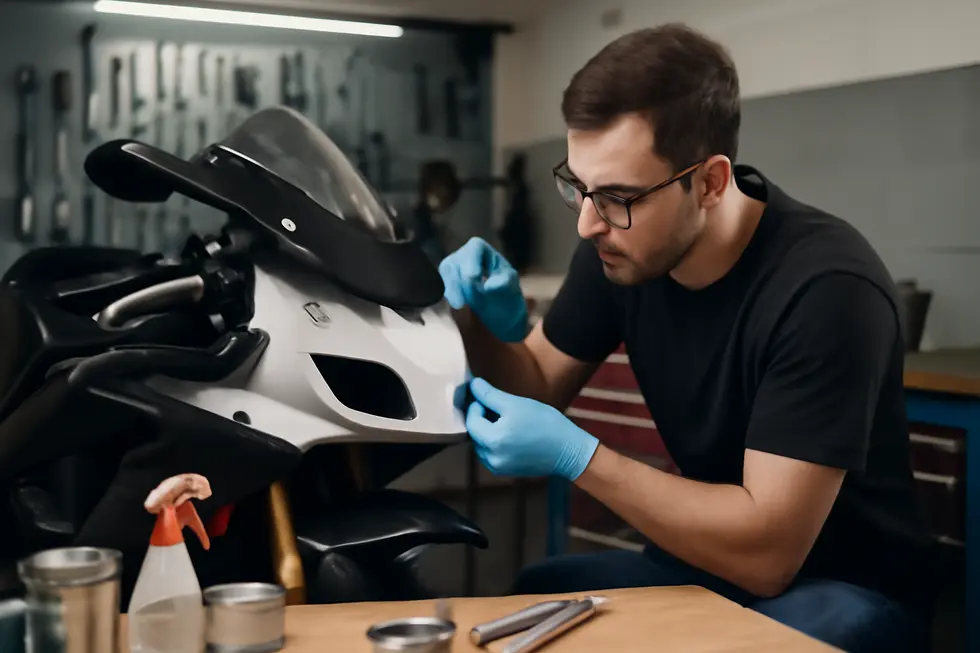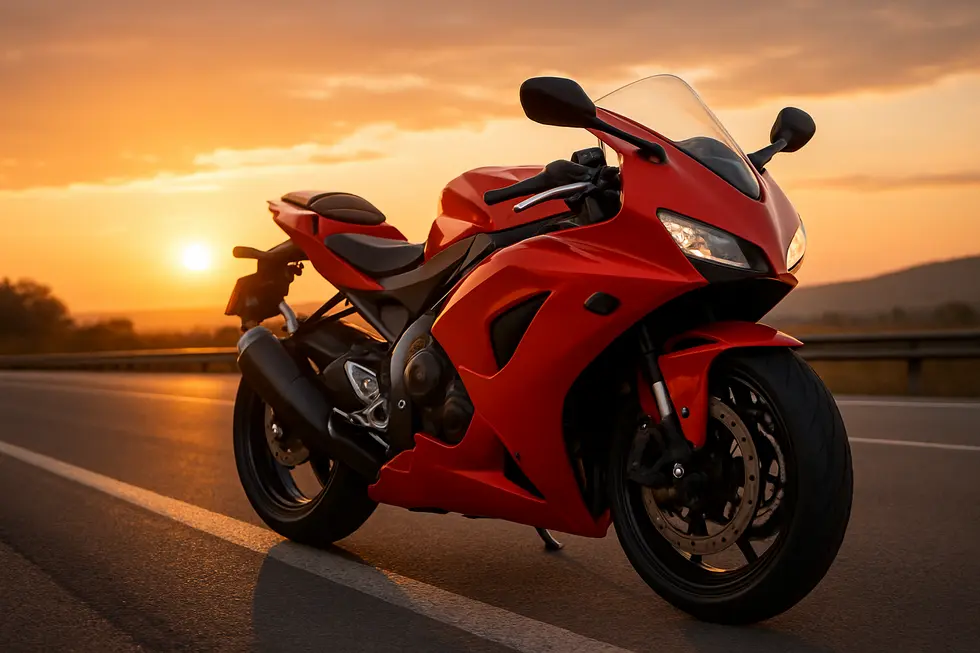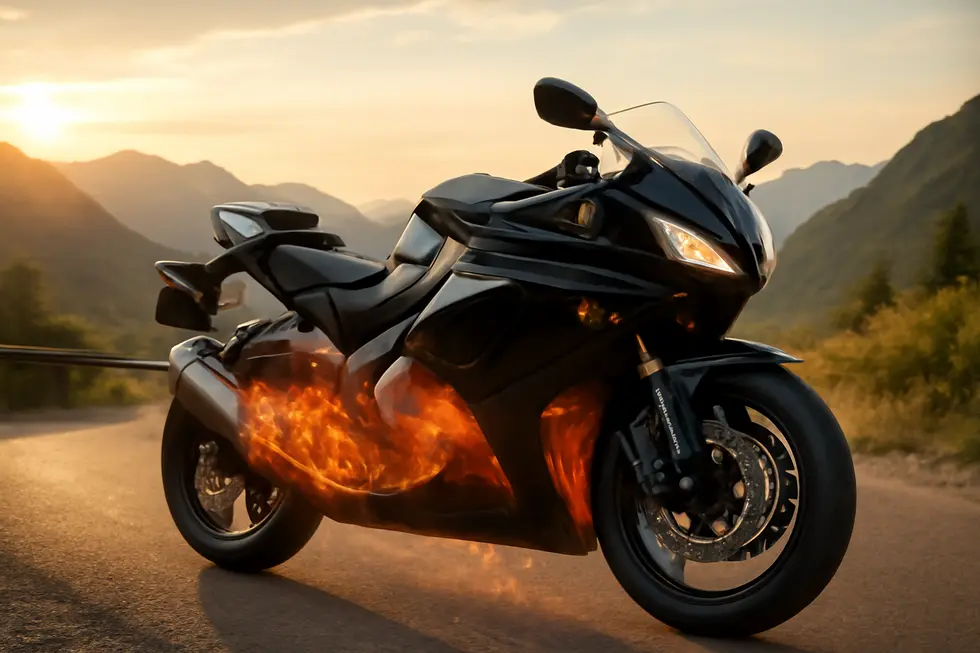Mastering Motorcycle Fairings: Boost Performance and Protection for Your Business
August 19, 2025 | by summitfairings
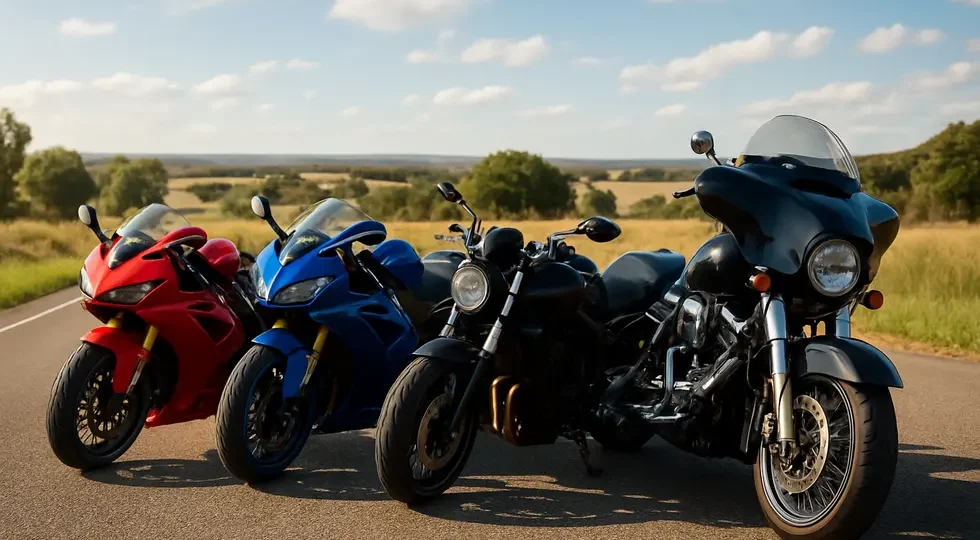
Introduction
Motorcycle fairings stand as a critical component for both performance enhancement and rider protection. Designed to streamline airflow, reduce wind resistance, and shield riders from environmental factors, these aerodynamic shells shape the motorcycle’s identity and capabilities. For business owners in the motorcycle industry, understanding the multifaceted benefits and applications of fairings is essential for delivering superior products and services. This article delves into the aerodynamic principles behind fairings, examines the diverse types and structural designs tailored to varied needs, and highlights the additional features that extend their practical utility beyond aesthetics and speed. Each chapter integrates key concepts relevant to fairings, building a comprehensive perspective that supports informed decisions in motorcycle sales, customization, or manufacturing.
Tables of Contents
Chapter 1: Aerodynamics and Performance of Fairing on a Motorcycle
- How Motorcycle Fairing Design Shapes Drag Reduction and Speed Optimization
- How Materials and Construction Shape the Weight, Strength, and Aerodynamics of Motorcycle Fairings
- How Motorcycle Fairings Enhance Rider Comfort by Reducing Wind Fatigue
- How Downforce from Fairings Enhances Traction, Stability, and Handling
- Shaping Speed: How Racing Rules and Regulations Drive the Evolution of Motorcycle Fairings
Chapter 2: Types and Functional Design of Fairing on a Motorcycle
- Full Fairings on Motorcycles: Enhancing Aerodynamics and Rider Protection Through Thoughtful Design
- Balancing Aerodynamics and Style: The Functional Appeal of Half and Quarter Motorcycle Fairings
- Lower Fairing Innovations: Balancing Engine Shielding and Streamlined Underbody Aerodynamics
- Design and Functional Roles of Tank Covers and Side Panels: Balancing Customization, Protection, and Aerodynamic Refinement
- Materials and Styling of Motorcycle Fairings: The Role of ABS Plastic and Accessory Integration
Chapter 3: Additional Features and Practical Uses of Fairing on a Motorcycle
- How Aerodynamic Design and Stability Features Elevate Motorcycle Fairings Beyond Basics
- Enhancing Safety and Comfort: The Protective Role and Rider Benefits of Motorcycle Fairings
- Cutting-Edge Materials and Functional Durability Elevating Motorcycle Fairings
- Balancing Maintenance and Practicality Across Different Motorcycle Fairings
- The Vital Role of Fairings in Enhancing Rider Safety, Performance, and Reducing Fatigue
Chapter 1: Aerodynamics and Performance of Fairing on a Motorcycle
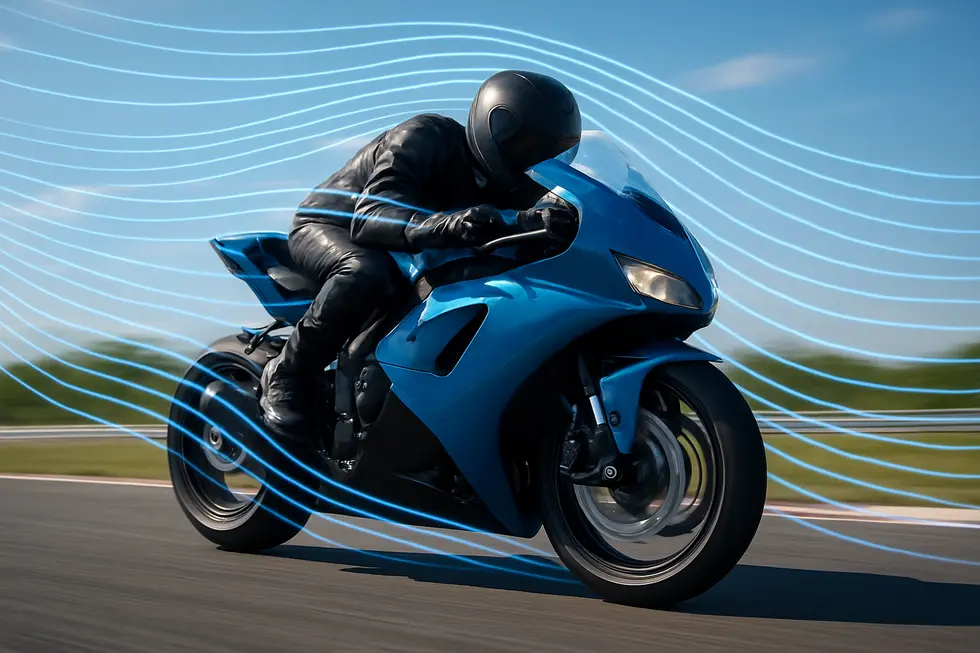
1. How Motorcycle Fairing Design Shapes Drag Reduction and Speed Optimization
Motorcycle fairing design plays an essential role in sculpting airflow to minimize drag and maximize speed. By streamlining the shape of the bike and its rider, the fairing slices through oncoming wind rather than battling it, resulting in a significant decrease in air resistance. This aerodynamic efficiency not only boosts top-end velocity but also enhances stability, particularly at racing speeds where even slight turbulence can destabilize handling.
Fairings achieve drag reduction through smooth, continuous contours that deflect airflow along the motorcycle’s profile. For instance, advanced carbon fiber fairings can cut drag by up to 20%, directly translating into improved acceleration and fuel economy. The careful shaping reduces chaotic wake turbulence behind the bike, allowing air to reattach smoothly and maintain a lower drag coefficient.
Beyond simple drag reduction, certain designs incorporate features to generate downforce. This effect presses the motorcycle onto the road surface, heightening tire grip and enabling more confident braking and sharper cornering at high velocity. However, designers must balance the fairing’s size and shape carefully; while larger, well-contoured fairings enhance aerodynamic smoothness, excess bulk can hinder maneuverability or restrict fork movement.
Positioning of fairing elements is equally consequential. Shifting the fairing nose backward or narrowing upper fairing sections reduces the frontal area exposure and redistributes aerodynamic loads, improving front tire loading and wake behavior. These principles align closely with professional regulations, like those in MotoGP, which aim to optimize fairing-induced downforce and drag balance.
This intricate relationship between geometry, material, and placement defines fairing effectiveness. Optimized designs allow racers and sport riders to sustain higher speeds with greater control and less rider fatigue. Those interested in deeper insights into race-specific fairing benefits can explore detailed visual explanations, such as those provided by expert resources like The Racing Xpert.
For more on the benefits and design variety of motorcycle fairings, this exploration of comprehensive motorcycle fairings offers valuable information. Additionally, Motorsport Magazine provides in-depth analysis of MotoGP fairing aerodynamics and performance impacts.
2. How Materials and Construction Shape the Weight, Strength, and Aerodynamics of Motorcycle Fairings
Motorcycle fairings are not just aerodynamic shells; their materials and construction critically influence the bike’s performance through weight management, durability, and aerodynamic efficiency. The choice of material determines how effectively a fairing balances lightness with structural strength, directly impacting speed, handling, and stability.
Carbon fiber stands out as the premier material for high-performance fairings. Its exceptionally low weight paired with remarkable strength allows designers to craft smooth, intricate shapes that minimize air turbulence and drag. This lightweight nature enhances acceleration and maneuverability while resisting fatigue and impact stresses common in racing and aggressive riding. Despite its manufacturing complexity and higher cost, carbon fiber’s benefits outweigh drawbacks where performance is paramount.
Fiberglass and plastic composites, by contrast, often introduce trade-offs between cost, weight, and durability. These materials tend to be heavier and less resilient, which can slightly reduce aerodynamic gains and wear resistance, especially under demanding conditions. However, they remain popular alternatives for street motorcycles where budgets and repairability weigh more heavily.
Construction techniques further amplify material advantages. Using lightweight, rigid framework such as extruded aluminum ensures the fairing maintains shape and withstands forces without adding unnecessary mass. For example, some iconic sport motorcycles combine carbon fiber skins with aluminum supports to achieve optimized dynamics and durability.
Beyond weight, the fairing’s shape—enabled by flexible materials and precise construction—affects how air flows around the motorcycle. Aerodynamic fairings not only reduce drag but generate downforce, which boosts tire grip and stability during acceleration, braking, and cornering. This integration of materials, construction, and design creates a finely tuned balance between speed, protection, and handling responsiveness.
For a deeper look into how construction pairs with materials for ultimate aerodynamic results, the technical insights provided in “What Is A Race Motorcycle Fairing? – The Racing Xpert” offer practical examples of these principles in action (https://youtube.com).
For those exploring options, Summit Fairings blog provides comprehensive resources on material choices and construction styles tailored for diverse motorcycle needs.
3. How Motorcycle Fairings Enhance Rider Comfort by Reducing Wind Fatigue
Motorcycle fairings are essential not only for aerodynamic efficiency but also for significantly improving rider comfort during extended journeys. Designed as streamlined shells enveloping the front, sides, and sometimes the lower belly of the motorcycle, fairings skillfully manage airflow to reduce drag and turbulence. This streamlined airflow forms a protective barrier, commonly described as a “bubble of calm air,” especially around critical rider zones such as the hands and shoulders. By deflecting strong winds and minimizing buffeting, fairings lessen the rider’s exposure to turbulent air currents, which is a major factor in fatigue during long rides.
This aerodynamic sheltering effect means that riders expend less physical effort compensating for destabilizing wind forces, leading to reduced muscle strain and improved endurance. For touring motorcycles, this translates to more comfortable and less tiring trips, while in high-speed racing scenarios, such as MotoGP, precise fairing designs balance aerodynamic performance with rider stability to maintain control and minimize fatigue under extreme conditions. Adjustments to fairing shapes in racing also manage downforce, enhancing grip without overwhelming rider stability.
Furthermore, maintaining a clean, polished surface on fairings helps sustain laminar airflow, further diminishing drag and enhancing the smoothness of air around the rider’s body. This careful integration of aerodynamic efficiency and ergonomic protection makes fairings indispensable for riders seeking both performance and comfort. By shielding riders from relentless wind pressure and turbulence, fairings directly contribute to lowering physical fatigue, allowing focus on handling and safety.
For riders interested in exploring a wide selection of fairing options optimized for comfort and performance, comprehensive resources such as explore the best motorcycle fairings at Summit Fairings offer detailed guidance.
Learn more about race fairings and their aerodynamic advantages in the video “What Is A Race Motorcycle Fairing? – The Racing Xpert” to deepen understanding of fairing impact on rider comfort and fatigue reduction.
4. How Downforce from Fairings Enhances Traction, Stability, and Handling
Motorcycle fairings serve a vital aerodynamic function by generating downforce, which presses the bike more firmly against the road surface. This increase in vertical load on the tires directly improves traction, allowing the motorcycle to maintain better grip during acceleration, braking, and cornering. Enhanced downforce reduces phenomena such as front wheel lift and wheelies that can unsettle rider control at high speeds, contributing to superior stability. Riders benefit by gaining confidence to brake later, carry higher speeds through corners, and maintain throttle application longer.
Fairing design plays a crucial role in creating effective downforce without compromising other performance factors. Integrated winglets are among the most advanced features, capable of producing substantial downforce—some examples reach around 37 kg (81 lbs) at speeds of 300 km/h. These aerodynamic elements stabilize the motorcycle during high-speed straights and sudden directional changes, enabling smoother handling and improved control. Beyond downforce, the fairing’s streamlined shape reduces drag by smoothing airflow around the bike and rider, creating a calmer air bubble that enhances comfort and lessens fatigue.
However, increased aerodynamic elements can present trade-offs. Full fairings offering maximum downforce and protection may restrict handlebar or fork movement, potentially limiting maneuverability. This balance becomes especially critical in competitive contexts where regulations, such as upcoming MotoGP aero rules for 2027, seek to limit fairing dimensions to control downforce and maintain rider safety while preserving high performance.
Overall, the carefully engineered downforce generated by motorcycle fairings significantly elevates tire grip and enhances dynamic stability. This balance of aerodynamic benefits and controlled maneuverability is essential for achieving peak handling performance. For riders interested in exploring a diverse range of fairing designs that optimize these aerodynamic advantages, resources like “Explore the Best Motorcycle Fairings at Summit Fairings” offer extensive insights. For a detailed discussion of regulatory impacts, see the article on MotoGP aero bans and evolution.
5. Shaping Speed: How Racing Rules and Regulations Drive the Evolution of Motorcycle Fairings
Motorcycle fairings are born from the delicate balance between maximizing aerodynamic efficiency and adhering to evolving regulatory frameworks that govern racing and safety standards. In high-level competitions like MotoGP, fairings extend beyond mere cosmetic enhancements—they are fundamental to reducing drag, generating downforce, and improving rider stability. Aerodynamic features such as streamlined noses, side panels, and winglets are carefully engineered to optimize airflow and tire grip, boosting cornering speed and straight-line stability without compromising control.
However, regulatory bodies regularly impose dimensional and aerodynamic restrictions to ensure safety and competitive equity. For example, the upcoming 2027 MotoGP regulations mandate reductions in front fairing size, nose repositioning, and rear fairing height cuts to limit excessive downforce and turbulence. These constraints compel manufacturers to redesign fairings within new spatial boundaries while striving to maintain or improve performance. The result is an ongoing cycle where technological innovation in aerodynamic materials, shapes, and integration must respond to these rule changes.
This dynamic interplay fosters continuous evolution, pushing engineers to find creative solutions that balance airflow management, weight, and rider protection. Innovations such as refined wing profiles or novel airflow channels emerge to reclaim lost efficiency under tighter regulations. Additionally, as rules clamp down on aerodynamic appendages, manufacturers pivot to enhancing other fairing aspects like drag reduction and rider shielding.
This regulatory-driven evolution influences not only race machines but also trickles down to consumer sport bikes, where principles of efficient aerodynamics derived from racing help enhance everyday performance, comfort, and safety. For those interested in exploring the nuances of aerodynamic fairing design and their role in modern motorcycle engineering, further insights can be found in detailed technical discussions such as those from Motorsport Magazine’s coverage of upcoming race regulations.
For a broader perspective on fairing types and their aerodynamic impacts on rider comfort and motorcycle efficiency, visit this insightful resource on motorcycle fairings.
External Reference: Motorsport Magazine, Coverage on MotoGP 2027 Aerodynamic Rule Changes
Chapter 2: Types and Functional Design of Fairing on a Motorcycle
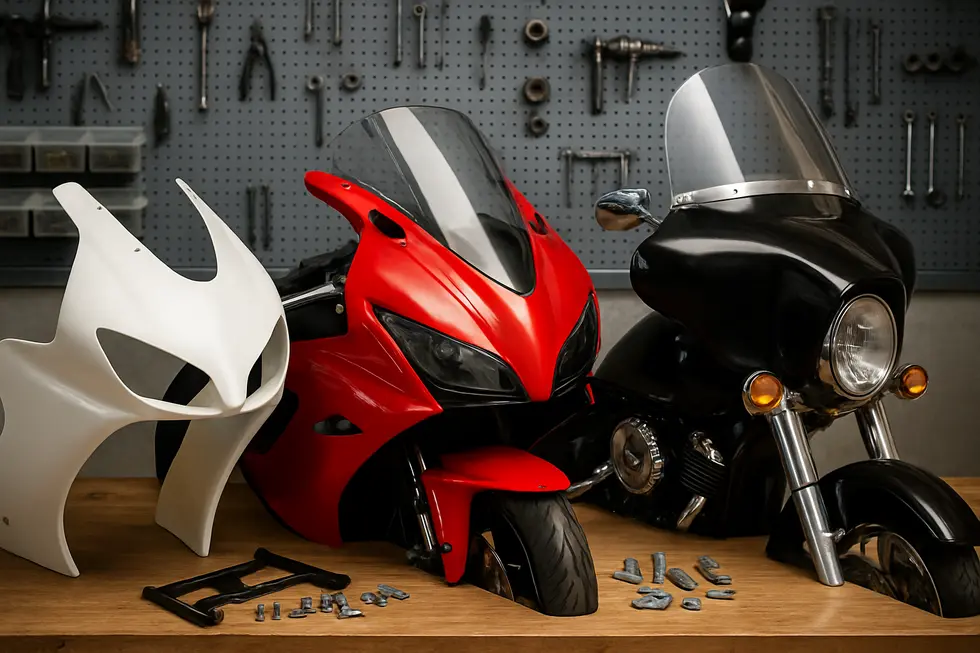
1. Full Fairings on Motorcycles: Enhancing Aerodynamics and Rider Protection Through Thoughtful Design
Full fairings represent the most comprehensive aerodynamic bodywork on motorcycles, enveloping the front and both sides to create a streamlined silhouette that greatly reduces drag. By directing airflow smoothly around the bike and rider, these fairings not only enhance top-end speed but also improve stability at higher velocities. This reduction in air resistance lessens rider fatigue by shielding against wind blast and deflects airborne debris, while also protecting vital engine components from potential damage. Integral to full fairings is the windshield, which often curves and angles carefully to optimize airflow over the rider’s helmet and shoulders, contributing to a more comfortable and controlled riding experience.
Materials used in full fairings vary according to purpose and performance demands. Lightweight, durable options like ABS plastics strike a balance for everyday rides, while carbon fiber composites dominate racing applications due to their exceptional strength-to-weight ratio. This material choice directly influences handling and acceleration, as reducing mass without sacrificing strength benefits rider control and motorcycle responsiveness.
Functionally, full fairings are tailored to the riding discipline. Race-oriented fairings focus on extreme aerodynamic efficiency, employing sleek shapes and advanced materials to maximize speed and agility. Conversely, sport touring fairings balance wind protection with long-distance comfort, often featuring integrated mirrors and adjustable windscreens designed to minimize rider fatigue during extended journeys. Custom and replacement fairings can merge aesthetic appeal with OEM-fit efficiency, offering diverse styles and finishes that retain the aerodynamic and protective essentials.
An example of effective full fairing design is seen in models that integrate aerodynamic mirrors and optional taller windscreens, emphasizing both performance and rider comfort. For those interested in exploring comprehensive options that combine durability, style, and aerodynamic function, the range of aftermarket kits offers vast customization possibilities while maintaining essential protective features. For more on choosing the right fairing and understanding its benefits, visit Summit Fairings.
Further insights on race motorcycle fairings and their role in performance can be found in the detailed video “What Is A Race Motorcycle Fairing? – The Racing Xpert.”
2. Balancing Aerodynamics and Style: The Functional Appeal of Half and Quarter Motorcycle Fairings
Half and quarter fairings occupy a unique space in motorcycle design by blending aerodynamic function with distinctive visual character. Unlike full fairings that envelop much of the bike, half fairings typically mount to the front forks, covering the upper area around the headlight and instruments. This arrangement provides moderate wind deflection, shielding the rider’s chest and face enough to reduce fatigue on longer rides without overburdening the bike with weight or bulk. Their design offers a functional compromise favored by cruiser models that seek to preserve classic styling cues while benefiting from improved airflow management.
Quarter fairings take an even more minimalist approach, focusing primarily on styling with limited aerodynamic coverage. Positioned just above or around the headlight, these small fairings slice through the air enough to slightly soften wind impact but mainly serve to emphasize aggressive, sporty aesthetics. This makes them popular on motorcycles where a sleek, purposeful appearance is a priority, allowing riders to achieve an aerodynamic edge without sacrificing a stripped-down look.
Both fairing types highlight the manufacturer’s challenge of balancing airflow control and visual identity. Half fairings emphasize rider comfort on touring or longer rides, carefully redirecting air around vital upper body regions while maintaining a traditional cruiser silhouette. Quarter fairings, meanwhile, prioritize sharp, minimalist form and light frontal protection, catering to those seeking the thrill of wind but with a touch of purposeful styling.
Together, they represent subtler aerodynamic solutions that respond to rider needs and market trends, with half fairings appealing to comfort-focused riders and quarter fairings attracting those who prefer minimalism fused with aggressive design. For those interested in exploring a wide range of functional and stylistic fairing options, discovering comprehensive motorcycle fairings can reveal the perfect balance of form and function. What Is A Race Motorcycle Fairing? – The Racing Xpert also provides insightful perspective on how different designs affect performance.
3. Lower Fairing Innovations: Balancing Engine Shielding and Streamlined Underbody Aerodynamics
The lower fairing on a motorcycle plays a crucial role beyond mere aesthetics, serving as a protective barrier and an aerodynamic enhancer. Positioned beneath the engine, it is engineered to shield critical components from road debris, water splashes, and other hazards encountered during rides. This protection ensures the longevity of vital engine parts, reducing the risk of mechanical issues caused by impact or contamination.
Simultaneously, the lower fairing smooths the airflow under the bike, effectively minimizing turbulence and drag. By refining underbody aerodynamics, it improves overall stability and performance, particularly at higher speeds where uncontrolled airflow can destabilize the motorcycle. This aerodynamic management contributes to enhanced rider confidence and more efficient riding dynamics.
There are three main types of lower fairings, each tailored to different needs and motorcycle styles. Full lower fairings, typical on sportbikes, envelop most of the engine’s underside and sides, delivering maximum protection coupled with sleek aerodynamic benefits. Partial lower fairings, often called belly pans, cover only the bottom area to reduce weight while still offering moderate aerodynamic improvement. Aftermarket lower fairings provide riders with the option to upgrade using lightweight ABS plastic panels, some featuring stylistic elements such as faux carbon fiber finishes to blend function with visual appeal.
Material selection for lower fairings prioritizes durable, lightweight solutions like high-grade ABS plastic to ensure resilience without compromising performance. Designs vary according to motorcycle type; sportbikes favor streamlined, extensive lower fairings for aerodynamic optimization, whereas adventure bikes often adopt sturdier, more rugged panels tailored for off-road durability.
Through this dual functionality—engine safeguarding and aerodynamic refinement—the lower fairing stands as a sophisticated component that significantly influences a motorcycle’s protection and ride quality. For riders interested in exploring a variety of options and designs, exploring the best motorcycle fairings at Summit Fairings offers a comprehensive resource. Further technical insights into race motorcycle fairings can be found in specialized video explanations such as “What Is A Race Motorcycle Fairing? – The Racing Xpert” [1].
4. Design and Functional Roles of Tank Covers and Side Panels: Balancing Customization, Protection, and Aerodynamic Refinement
Motorcycle tank covers and side panels play a nuanced but essential role in the overall fairing system by blending customization, protection, and subtle aerodynamic improvements. Unlike the primary fairing elements that focus on major air resistance reduction, these components serve dual purposes that enhance the motorcycle’s aesthetics and rider interaction while contributing modestly to airflow management.
Tank covers are often the canvas for personalization, with leather designs offering a classic, rugged appearance and practical resistance against scratches caused by rider gear. These leather covers, featuring popular motifs like skulls or flames, allow riders to express individuality without sacrificing utility. In contrast, carbon fiber tank protectors provide a high-tech alternative, combining lightweight durability with scratch resistance. Their smooth, sleek finish enhances airflow continuity over the tank, offering a small but meaningful aerodynamic advantage.
Tank pads also serve a defensive function, preventing abrasion from zips or belts. Their adhesive-backed design ensures they conform closely to the tank’s contours, smoothing the surface and thus reducing airflow disruptions around this critical midsection.
Side panels, though less overtly customizable, are integral to ergonomic design and rider stability. Modern sport motorcycles utilize the side panels alongside the rear tank shape and seat to optimize rider positioning, especially during dynamic maneuvers like braking and cornering. This ergonomic integration reduces rider fatigue and subtly refines aerodynamic flow by minimizing turbulence caused by rider movement.
Together, these components illustrate how fairing design extends beyond pure aerodynamics. By enhancing rider comfort, protecting vulnerable surfaces, and refining airflow where possible, tank covers and side panels contribute valued synergy within the motorcycle’s aerodynamic architecture.
For those interested in exploring comprehensive options tailored for diverse motorcycle models, a detailed resource on motorcycle fairings can be found at Summit Fairings.
Additionally, for an in-depth understanding of aerodynamic priorities in racing contexts, the video “What Is A Race Motorcycle Fairing? – The Racing Xpert” offers expert insights.
5. Materials and Styling of Motorcycle Fairings: The Role of ABS Plastic and Accessory Integration
Motorcycle fairings are crafted not only for performance but also for durability, aesthetics, and compatibility with rider-specific upgrades. Among the materials used, ABS plastic stands out due to its exceptional balance of lightweight construction and impact resistance. This thermoplastic is favored because it can be molded into complex aerodynamic shapes that improve airflow while maintaining strength and UV resistance, essential for sustained outdoor riding conditions. Beyond practical benefits, ABS plastic offers great versatility in styling—manufacturers and customizers frequently apply finishes such as faux carbon fiber textures or vibrant vinyl graphics, allowing riders to tailor their bike’s appearance without the premium cost of actual carbon fiber.
For high-performance motorcycles, carbon fiber composites serve as an advanced alternative, delivering superior strength-to-weight ratios and improved thermal tolerance. These materials reduce drag notably, enhancing speed and stability in racing contexts. Meanwhile, more environmentally conscious options like biomass-based plastics (such as DURABIO™) are emerging, integrating recycled components while minimizing carbon emissions during manufacture.
Styling enhancements often come paired with accessory integration designed with precise fitment standards. ABS plastic fairings can seamlessly accommodate aerodynamic spoilers or winglets, accessories that both refine airflow and add aggressive visual accents. Such modular components typically include mounting hardware engineered for secure, user-friendly installation, enabling riders to upgrade performance aspects without compromising the original fairing structure. This synergy between material properties and design flexibility makes ABS plastic-based fairings a popular choice across diverse rider profiles, from practical daily commuters to custom builders seeking unique looks.
For a wide range of motorcycles, especially sport and race models, these design considerations converge to create fairings that excel in aerodynamic efficiency, durability, and customizable styling. To explore comprehensive options and accessory compatibility, visiting a reliable source dedicated to motorcycle fairings offers valuable insights into matching materials and designs for specific models.
For further understanding of race-specific fairings and their impact, the video “What Is A Race Motorcycle Fairing? – The Racing Xpert” provides detailed expert analysis.
Chapter 3: Additional Features and Practical Uses of Fairing on a Motorcycle
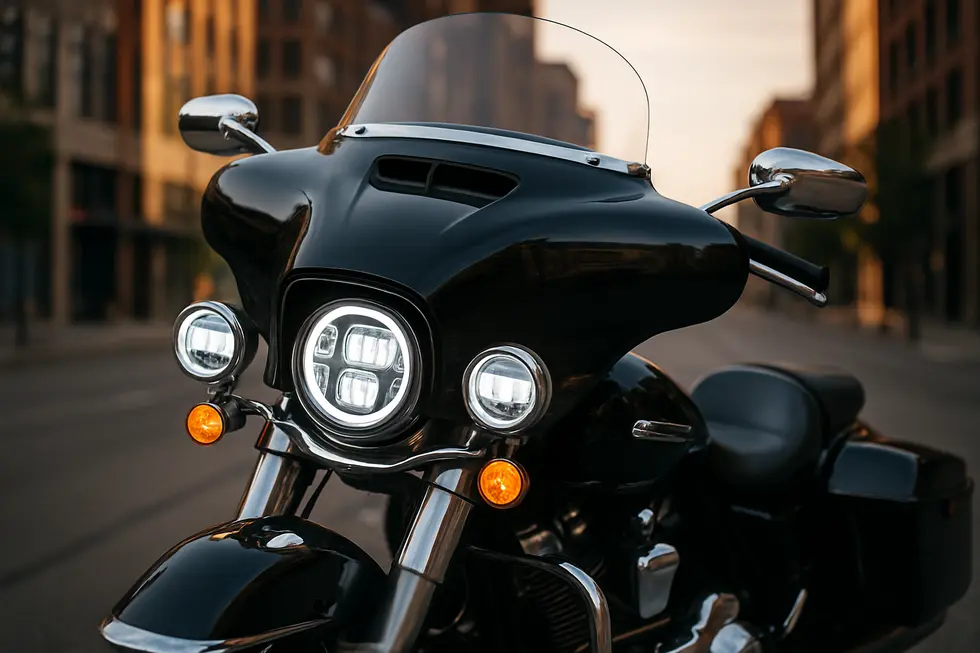
1. How Aerodynamic Design and Stability Features Elevate Motorcycle Fairings Beyond Basics
Motorcycle fairings are essential not only for sleek appearance but primarily for their critical role in enhancing aerodynamic stability. By expertly channeling airflow around the bike, fairings reduce drag and turbulence that can destabilize the rider at higher speeds. This controlled airflow cuts down on air resistance, allowing the motorcycle to maintain steadier handling and improved control on highways or winding roads. A significant advantage comes from reducing the effect of crosswinds, which often cause unpredictable sideways pressure. Fairings minimize the exposed surface area vulnerable to these gusts, helping riders avoid sudden loss of balance or control.
Modern fairings also incorporate advanced aerodynamic elements like winglets, designed to generate downforce. This downward pressure increases tire grip, boosting traction and cornering stability without sacrificing speed. The degree of aerodynamic coverage varies with fairing types: full fairings envelop the bike’s front and sides, maximizing air resistance reduction and protecting mechanical elements, while half fairings provide a middle ground, offering moderate drag improvement with easier maintenance access.
Beyond pure performance, these aerodynamic designs help deflect wind from the rider, reducing fatigue on long journeys or at sustained speeds. Fairings act as shields against debris and small impacts, safeguarding both rider and critical components from harm. This combination of aerodynamic finesse and practical protection culminates in a safer and more comfortable ride. Race fairings take this to the extreme with streamlined shells focused on peak speed and stability on tracks, whereas street models blend these performance gains with everyday usability. For riders interested in exploring suitable options, comprehensive guidance on available styles and features can be found through detailed sources like Explore the Best Motorcycle Fairings at Summit Fairings.
Further insights into race fairing design and function can be explored in specialized videos such as “What Is A Race Motorcycle Fairing? – The Racing Xpert,” which describe their impact on handling and speed.[3]
2. Enhancing Safety and Comfort: The Protective Role and Rider Benefits of Motorcycle Fairings
Motorcycle fairings offer far more than aerodynamic advantages; they serve as a critical barrier protecting both rider and machine. By shielding riders from relentless wind blasts, debris, and minor impacts, fairings significantly reduce rider fatigue while enhancing safety. This protective shell helps preserve rider focus and comfort, especially during long-distance journeys or high-speed travel where wind pressure can be exhausting.
Beyond shielding, fairings contribute to greater stability by minimizing the effects of crosswinds. Their streamlined design improves tire contact and grip, which is vital for maintaining control through curves or in variable weather conditions. Different styles of fairings reflect varied approaches to comfort: for example, a handlebar-mounted fairing allows a more tactile steering feel but may offer less wind deflection, whereas a fixed frame-mounted fairing provides superior wind protection, easing fatigue on extended rides.
Integrated windshields embedded within many fairings further refine airflow, reducing pressure on the rider’s helmet and upper body. This not only enhances comfort but also diminishes noise from turbulent air, contributing to a calmer riding experience. Fairings also protect sensitive engine components and wiring from debris and minor impacts, safeguarding the motorcycle’s longevity and performance.
Maintaining these benefits requires regular inspection and repair of any damage to the fairings. Cracks or loosened mounts can compromise their protective function and stability, which underscores the importance of proper care.
For riders seeking variety and tailored solutions, complete fairing kits provide options to balance protection, aesthetic appeal, and performance enhancements. Learn more about the range of motorcycle fairings and their features at Summit Fairings.
For a deeper dive into race fairings and their impact on performance, the video “What Is A Race Motorcycle Fairing? – The Racing Xpert” offers detailed insights.
3. Cutting-Edge Materials and Functional Durability Elevating Motorcycle Fairings
Motorcycle fairings have evolved far beyond simple protective shells, thanks to advances in materials science and design innovation. Modern fairings leverage high-tech composites to enhance both durability and functional performance while addressing the demands of aerodynamic efficiency and rider comfort. Among the most impactful material innovations are carbon fiber composites, prized for their exceptional strength-to-weight ratio and resistance to corrosion and heat. These composites reduce the overall weight of the fairing by 30 to 50 percent compared to traditional fiberglass or aluminum, leading to improved acceleration, fuel efficiency, and handling. Their UV-resistant coatings also ensure long-lasting aesthetics and reliability under harsh environmental exposure, making them ideal for high-performance and luxury motorcycles.
In parallel, eco-conscious materials like biomass plastics have gained traction, combining sustainability with the capability to produce high-gloss, durable fairings. These materials significantly reduce the carbon footprint during manufacturing without sacrificing visual appeal or strength. Recycled plastics further contribute to environmental goals while maintaining robustness, commonly used for ancillary parts such as luggage covers. This approach reflects a growing industry trend toward greener production practices.
Beyond materials, practical design features such as adjustable windscreens provide significant ergonomic benefits. Tool-free height adjustments allow riders to customize airflow and reduce fatigue on long rides. Fairing styles vary from handlebar-mounted designs, which enhance steering feedback, to frame-mounted configurations optimized for wind deflection and stability. These functional choices directly impact rider experience, balancing comfort and control.
Customization also plays a vital role, with options ranging from color-matched paints to textured vinyl wraps that add style and daily durability. This fusion of tailored design and advanced materials transforms fairings into multifaceted components that protect, optimize performance, and express rider personality. Such progress in materials and features undeniably deepens the practical significance of fairings in modern motorcycling.
For deeper insight into available customization options and styles, explore a wide selection of motorcycle fairings at Summit Fairings. Learn more about the innovative use of carbon fiber composites and eco-friendly materials from detailed manufacturer case studies and expert reports here.
Reference: Ilmberger Carbon BMW S1000RR fairing parts featuring UV-resistant coatings.
4. Balancing Maintenance and Practicality Across Different Motorcycle Fairings
Motorcycle fairings vary widely not only in their design but also in the maintenance demands and practical benefits they offer, creating important considerations for riders. Full fairings, often made from materials like carbon fiber or high-quality OEM plastics, deliver comprehensive wind and weather protection while significantly improving aerodynamic efficiency. These benefits come with the trade-off of increased complexity in upkeep. Carbon fiber fairings, valued for their light weight and strength, often require specialized repair methods and higher costs if damaged. Meanwhile, OEM plastics typically feature user-friendly designs with pre-drilled holes and heat shields, striking a practical balance between durability and ease of maintenance.
In contrast, half and quarter fairings present riders with simpler, more accessible options. Half fairings cater to touring riders seeking moderate wind protection without the maintenance burden of full coverage. Quarter fairings appeal to those prioritizing minimalist styling and quick upkeep, common on cafe racers or street bikes. Naked bikes, which omit fairings entirely, offer unmatched ease of access for maintenance but sacrifice wind protection, impacting comfort during longer rides. To improve practicality without adding complexity, riders sometimes add smaller windscreens or café-style fairings.
Beyond maintenance, fairings enhance everyday riding through improved aerodynamics, weather shielding, and accessory mounting capabilities. Modern fairings often support auxiliary lights, mirrors, and storage, expanding functionality. Materials like carbon fiber or 3D-printed plastics further empower riders to customize aesthetics and performance characteristics.
Regular care, including inspecting fasteners, cleaning to prevent wear, and monitoring for cracks, is essential to preserve fairing integrity. Overall, choosing the right fairing type involves balancing desired protection and style against maintenance effort and costs, tailored to individual riding needs and preferences.
For an in-depth overview of fairing materials, pricing, and features suited for both street and track use, the Yamaha R1 2024 fairing market offers valuable insights. Discover a wide array of options to find the perfect fairing that meets both practical and performance goals at Summit Fairings.
5. The Vital Role of Fairings in Enhancing Rider Safety, Performance, and Reducing Fatigue
Motorcycle fairings play a pivotal role beyond aerodynamic enhancement by significantly boosting rider safety, performance, and comfort during long rides. Their design effectively deflects wind and debris away from both the rider and key mechanical components, shielding against harsh weather conditions such as rain, cold air, and flying debris. This protective barrier not only preserves rider concentration but also prevents fatigue caused by sustained wind exposure. A well-maintained fairing ensures structural integrity, which is crucial, as loose or damaged panels can cause hazardous vibration or detachment, compromising safety.
From a performance standpoint, the aerodynamic form of fairings reduces drag, leading to improved fuel efficiency and heightened stability, especially at high speeds and in challenging conditions such as crosswinds. This stability fosters smoother handling, making the motorcycle more predictable and easier to control. Reduced wind forces also translate into less physical strain for the rider, as constant counteracting efforts against buffeting diminish.
Crucially, fairings contribute greatly to reducing rider fatigue by minimizing wind pressure on the body. Touring motorcycles featuring fixed sharknose styles exemplify this benefit by offering superior wind deflection compared to handlebar-mounted designs, easing long-distance travel comfort. Combined with ergonomic motorcycle designs and vibration damping technologies, fairings help preserve rider energy and focus.
Additional practical features like handguards complement fairings, further reducing wind noise and protecting hands without obstructing visibility. Maintaining these components through regular care and UV protection is essential to preserve their efficiency.
Incorporating fairings alongside advanced rider aids such as ABS and traction control creates a comprehensive safety and comfort package essential for long journeys and high-performance riding.
For a deeper understanding of fairing designs and their roles in performance and safety, resources such as the detailed discussion on race motorcycle fairings provide valuable insights. To explore a wide range of fairings for different riding needs, consider visiting Explore the Best Motorcycle Fairings at Summit Fairings.
Final thoughts
Motorcycle fairings are far more than cosmetic enhancements; they are engineered tools that significantly influence performance, rider experience, and motorcycle longevity. By optimizing aerodynamics, they reduce drag and increase speed and stability, which benefits racers and daily riders alike. Their diverse types and functional designs serve multiple use cases—from racing prototypes to comfortable touring setups—allowing businesses to target specific market segments effectively. Moreover, integrating additional features like lighting and weather protection broadens their value proposition, improving safety and comfort. For motorcycle business owners, mastering the comprehensive understanding of fairings opens pathways to smarter inventory choices, better customization options, and a competitive edge in the marketplace.
Ready to elevate your ride? Summit Fairings delivers premium, custom-fit fairings that blend style and durability. Whether you’re chasing speed or turning heads, we’ve got your bike covered. Don’t wait—transform your machine today. Click, customize, and ride with confidence. Your perfect fairing is just a few clicks away. Act now!
About us
We are one of the leading motorcycle fairing export sites, with over 3,000 styles across almost all motorcycle models. Buy from summitfairings.com, and pay 10-40% less than the prices on other sites. If you have any questions, we promise we will have your answer within six hours.
RELATED POSTS
View all

